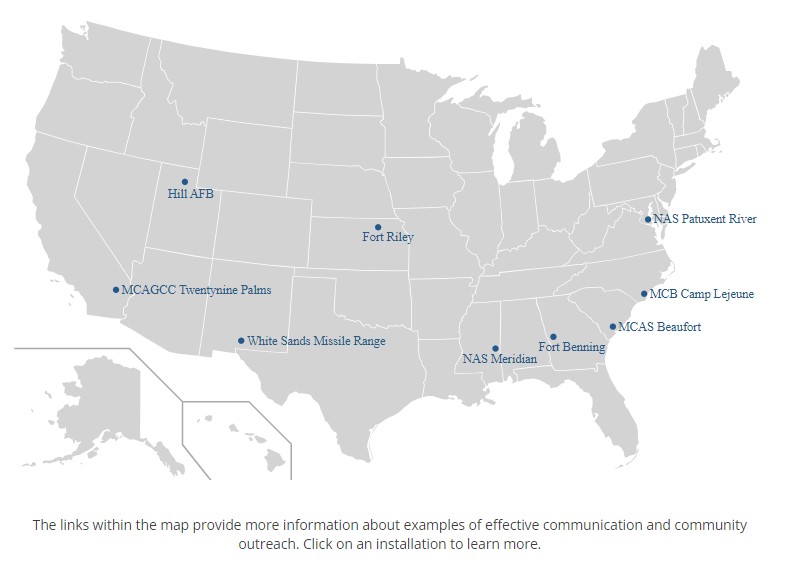Introduction
An effective community involvement program is proactive and demonstrates a commitment to preserving public trust. Community involvement activities can be implemented to encourage community input and minimize the effects of military noise on the community with the support of the installation commander and installation personnel.
Have a Community Involvement Strategy
Noise-related community involvement techniques and strategies best suited to address noise-related issues are integrated with an installation’s overall community engagement strategy. Community involvement is not a one-time occurrence; it is an ongoing part of public engagement. The installation’s Public Affairs Officer (PAO), Community Planning and Liaison Officers (CPLOs), and/or community involvement staff are strategic partners in noise-related community involvement efforts, helping integrate and coordinate efforts with the installation’s overall community engagement and communication efforts. For example, the PAO often shares information through social media, including public notifications of training events, and arranging tours, briefings and meetings with elected officials.
An effective community involvement program:
- builds trust and enhances relationships;
- educates and informs;
- increases the likelihood of public acceptance; and
- reduces potential impacts to missions.
SELECT AN INSTALLATION FOR EXAMPLES OF EFFECTIVE COMMUNICATION AND COMMUNITY OUTREACH

Know Your Stakeholders
The foundation of effective community involvement and communication is an understanding of the people and the issues. In noise management, stakeholders are those specifically concerned with noise issues. Stakeholders will likely include local government representatives (elected officials as well as staff) and community representatives (residents from communities adjacent to the installation, civic leagues, and business interests). On the installation, the PAO and CPLOs coordinate with various installation staff, range managers, and airfield operators to address noise complaints and issue press releases in advance of loud training events.
On-installation communities are also included in the stakeholder group. On-installation communities often provide input concerning the noise management program and have opportunities and outlets to express concerns related to the effects of training on their quality of life. On-base housing, schools, and daycare facilities can be impacted by military noise. Military installations strive to understand their neighboring communities, including military personnel and dependents who may live on base.
Matching communication tools to the situation
DoD conducts outreach and communication activities to involve and educate the public. Involving the public through the noise management program lets all stakeholders express their views and provides the military with information to influence training activities to minimize noise impacts. Which communications tools are most effective depends upon available resources, the amount of interest, and the communities’ preferred methods of receiving information.
Integrating Community Involvement Activities Into Your Installation’s Day-to-Day Business
Continuous and effective communication and coordination with the local community can sustain a positive relationship between the installation and its neighbors. Community noise management programs, community involvement activities, and complaint management systems are integrated into installation plans (e.g., training, land management, and master planning) that support installation operations. Noise is considered in all installation planning activities, such as the siting of new facilities and ranges. For the military, participation in regional planning meetings or establishing local installation-and-town advisory groups keeps the communication lines open. Many installations also have noise complaint hotlines and locations on the installation website where the community can report noise issues and concerns.
Informal opportunities to interact with the public are also beneficial. Frequent dissemination of noise-related information helps to maintain or improve relations with the public. The military sometimes uses advance notification of significant noise events to the public. Experience shows warning of activities that might cause annoyance seems to lessen, rather than increase annoyance.
Building lasting relationships with stakeholders:
- Participation in community meetings (Kiwanis, Chamber of Commerce, etc.), taking public questions, and fostering one-on-one conversations with community members.
- Meeting with the editorial boards of local newspapers.
- Telephone local officials; Establish contact and availability if they have any questions about the facility.
- Seek out community leaders or groups in the community who are interested in the process.
- Provide contact information to the public. Set up an email list to consistently communicate to many stakeholders simultaneously.


